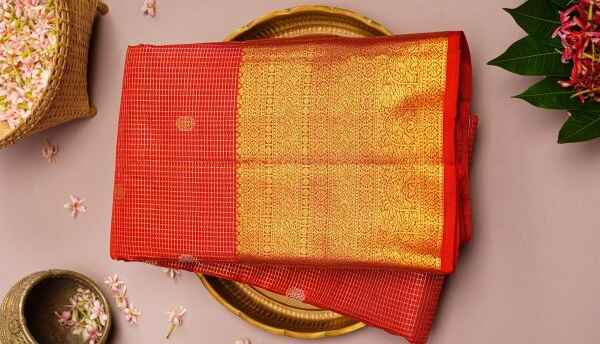India is renowned for its different textile traditions, and among the most celebrated is the Kanchipuram saree, often referred to as the “Queen of Silk Sarees.” Known for its rich fabric, vibrant colors, and intricate craftsmanship, this saree traces its roots to the town of Kanchipuram in Tamil Nadu. Let us delve into its origin, history, and other fascinating details.
The Origin of Kanchipuram Saree
The Kanchipuram saree originated in the town of Kanchipuram, also known as Kanchi, situated approximately 75 kilometers from Chennai. Often called the “Silk City of India,” this ancient town has been a hub for silk weaving for over 400 years.

The art of Kanchipuram weaving is believed to have been introduced by the Saligaars and Devangaars, two weaving communities who migrated to Tamil Nadu from Andhra Pradesh during the reign of the Vijayanagar Empire. These weavers brought with them age-old traditions and techniques of silk weaving, which they perfected over time to create the iconic Kanchipuram saree.
Historical Significance
The history of Kanchipuram sarees is deeply intertwined with South Indian culture and heritage. During the rule of the Chola dynasty, silk weaving flourished, as the Cholas were great patrons of art and textiles. Temples in Kanchipuram, such as the Kamakshi Amman Temple, played a significant role in inspiring motifs and patterns found on these sarees.
Kanchipuram sarees were not just garments but also symbols of wealth, status, and tradition. They were often worn during weddings, festivals, and other auspicious occasions. Over time, they became an integral part of South Indian bridal trousseaus, symbolizing prosperity and grace.
Features of Kanchipuram Saree
What sets Kanchipuram sarees apart is their exquisite craftsmanship and superior quality. These sarees are woven using pure mulberry silk, often sourced from Tamil Nadu and Karnataka, and zari (gold or silver threads) from Gujarat. The hallmark of a Kanchipuram saree is its durability and the seamless join between the border and the body, achieved through the korvai technique.
The motifs on Kanchipuram sarees draw inspiration from temple architecture, religious symbols, and nature. Common patterns include peacocks, chariots, mangoes, and leaves. The sarees are available in vibrant colors, often with contrasting borders, adding to their appeal.
Global Recognition
Kanchipuram sarees have gained international fame for their elegance and artistry. In 2005, the saree was granted the Geographical Indication (GI) tag, ensuring its authenticity and protecting the legacy of traditional weavers.
The Challenges and Future
Despite their popularity, Kanchipuram sarees face challenges, such as competition from machine-made imitations and dwindling numbers of traditional weavers. Efforts by the government and various organizations to promote handloom weaving and ensure fair wages have helped sustain this timeless art.
Conclusion
A Kanchipuram saree is not just a piece of clothing; it is a testament to India’s rich cultural heritage and craftsmanship. By choosing a genuine Kanchipuram saree, you not only embrace tradition but also support the skilled artisans who keep this legacy alive. As the world moves towards modernity, preserving such traditional arts ensures that our cultural roots remain intact for generations to come.

